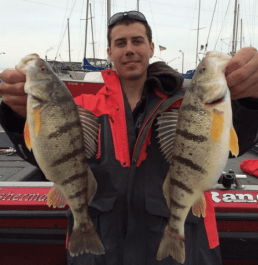How to catch “Jumbo” perch on Lake Michigan
SHARE THIS POST
Bobby Bergren goes in-depth on how to target great lakes perch during the month of November.
The south end of Lake Michigan is without one of the best natural perch fisheries in the country. The fall pattern for lake perch is fishing out on the clay flats north of U.S. Steel in Gary, Ind. They typically reside in 45- to 55-foot waters that have a clay bottom. There is a barrage of boats on top of active schools of fish. Drifting is by far the best way to find new active schools of perch, so you needn’t be a sight fisherman and bombard other anglers—There’s plenty of fish for everyone. Instead, use your electronics to find schools of perch. They normally school up in groups about the size of a school bus and can be easily seen on most graphs.
Are you enjoying this post?
You can be among the first to get the latest info on where to go, what to use and how to use it!
The best presentation in deep water is a perch rig, which is basically a feathered crappie rig; tip the hooks with baby roach minnows. Consider using a heavier weight (up to 1 ounce or more) that will fall quickly and hold at the bottom. The color of the tassels makes all the difference. Try white or shad patterns if the water is calm and clear; if the water is muddy, use a bright orange or green with glow beads so that perch can find your presentation in the deep, dark water. Larger perch normally lie on the clay bottom to warm their bellies. A little trick to catch these bigger perch is to drop your bait down and let out some extra line so the rig lies flat on the bottom.
To learn how to catch smallmouth bass, lake trout, and whitefish during the month of November, be sure to check out Bobby Bergren’s full article in the Indiana section of the November issue of MidWest Outdoors magazine, available the first full week of November at a newsstand near you.
MWO
SHARE THIS POST
You may also like...
Nothing found.
Did you enjoy this post?
You can be among the first to get the latest info on where to go, what to use and how to use it!
Bobby Bergren
“Bobby B” Bergren is a smallmouth bass fishing fanatic who’s passion is fishing the Great Lakes. He has multiple first-place tournament wins on Lake Michigan. Additionally, he is a die-hard ice fishing enthusiast who targets bluegills, and dabbles in hunting and knife collecting. Bergren also engages in content creation and digital marketing for MidWest Outdoors.
